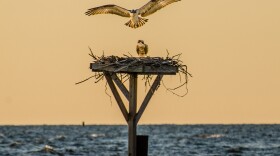Many people spend their weekends looking at houses. Some are in the market to buy. Others are just nosey, but recently Virginians toured a new building like no other in the nation – a place that gets all its water from rain, generates all the power it needs, has not a single flush toilet and keeps the floors clean in an ingenious way.
From a boat at the mouth of the Lynnhaven River you can see the new Brock Environmental Center. A long, low building made from wood and steel, it blends nicely with the landscape. Built by the Chesapeake Bay Foundation -- designed by D.C. architect Greg Mella, it features a curved roof, a wrap-around porch and a great view.
“We think people are happier in places where they can see nature and feel like they’re integrated with it.”

On either side of the one-story structure, two 80-foot wind turbines spin noiselessly. They were carefully placed to avoid flocks of migrating birds. Geothermal energy will heat and cool the building, and it’s been positioned to catch breezes and use natural light. There are solar panels on the roof and pipes that carry rainwater to a couple of storage tanks below. The Foundation’s Paul Willey thinks this could be the first commercial building in the nation to get all the water it needs from rain.
“Virginia Beach gets more rainfall than Seattle, Washington.”
There are showers inside for those who bike or kayak to work. The waste water will be used to irrigate plants that surround the building – and there’s one more big water saver – flushless toilets.

“These are our composting toilet bins. Upstairs are the bathrooms, and then there’s a chute. You do your business. It comes down the chute, and after three years you’ll have organic, clean compost. We’ve been using these for 30 years. They’re completely odorless.”
There are no toxic chemicals in the building materials, and many of them are recycled. Wood came from an old barn, the floor and bleachers from school gyms, and cypress logs found at the bottom of a river in Louisiana. The Foundation even put out a call for champagne corks, donated by the public to serve as handles on office drawers.
Architect Greg Mella adds this 10,000 square foot building is not just green but clean thanks to special grates in the porch floor. “When you come up the ramps, you’ve been stepping in sand. You walk across those grates. The sand will fall below, and you won’t be dragging all that dirt inside the building.”
There’s no parking lot -- no need to pave any more land. Instead, visitors will park school buses and cars on a nearby street, then walk down a winding woodland path to the building. One other thing makes the $5 million Brock Center a bargain, even if it did cost 20% more than conventional construction. It is, according to the Chesapeake Bay Foundation’s Senior Educator Bill Portlock a powerful place to teach people about green living.
“From the time they get off a bus, it’s a teachable moment.”
And the head of the Foundation’s Hampton Roads office, Christy Everett, hopes the building will also inspire the people who make policy for the state of Virginia.
“With 1.7 million people in the region, so much interaction with the waterways on a daily basis, so much of our economic revenue comes from water-based tourism, seafood, and so many political figures coming from Hampton Roads. A quarter of the general assembly is from Hampton Roads.”
The center is surrounded by 108 acres of grasses and wildflowers – property originally slated for development. “This property was proposed for 1,100 homes, two 11-story towers right on the water. In 2007 it was purchased for $25 million to do just that," said Christy Everett.
When the developer got into financial trouble, the city of Virginia Beach ponied up $10 million. The Chesapeake Bay Foundation and the federal government came up with a million dollars each, while the state and Dominion Power provided another million to buy the site.
Up to 30 people may eventually work in the new building. They’ll host as many as 125 visitors a day, and business could go on there for decades to come, as the building sits on pylons 14 feet above the ground, minimizing the risk of flooding as sea levels rise.










